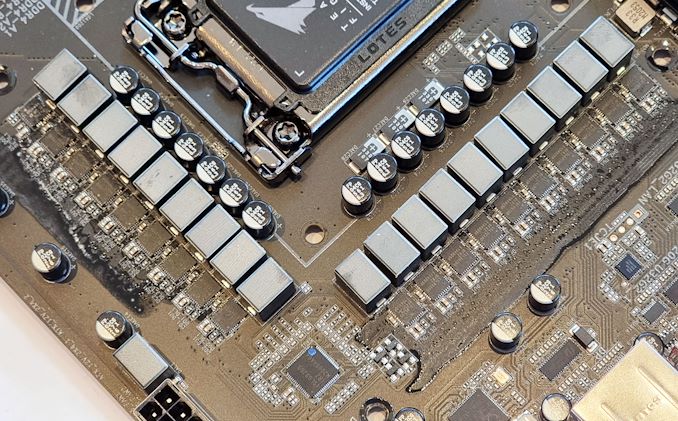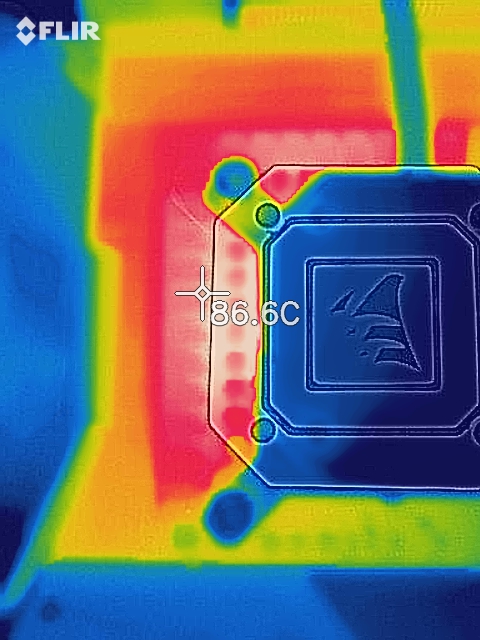GIGABYTE Z590 Aorus Master Review: Soaring High With Rocket Lake
by Gavin Bonshor on April 28, 2021 1:00 PM ESTPower Delivery Thermal Analysis
A lot more focus has been put on power delivery specifications and capabilities, not just by manufacturers but as a result of users' demands. In addition to the extra power benefits from things like overclocking, more efficient designs in power deliveries and cooling solutions aim to bring temperatures down. Although this isn't something most users ever need to worry about, certain enthusiasts are bringing more focus onto each board's power delivery. The more premium models tend to include bigger and higher-grade power deliveries, with bigger and more intricate heatsink designs, with some even providing water blocks on ranges such as the ASUS ROG Maximus Formula series and the ASRock Aqua.
 The 19-phase power delivery on the GIGABYTE Z590 Aorus Master (operating in 18+1)
The 19-phase power delivery on the GIGABYTE Z590 Aorus Master (operating in 18+1)
Testing Methodology
Our method of testing out if the power delivery and its heatsink are effective at dissipating heat, is by running an intensely heavy CPU workload for a prolonged method of time. We apply an overclock which is deemed safe and at the maximum that the silicon on our testbed processor allows. We then run the Prime95 with AVX2 enabled under a torture test for an hour at the maximum stable overclock we can which puts insane pressure on the processor. We collect our data via three different methods which include the following:
- Taking a thermal image from a birds-eye view after an hour with a Flir Pro thermal imaging camera
- Securing two probes on to the rear of the PCB, right underneath CPU VCore section of the power delivery for better parity in case a probe reports a faulty reading
- Taking a reading of the VRM temperature from the sensor reading within the HWInfo monitoring application
The reason for using three different methods is that some sensors can read inaccurate temperatures, which can give very erratic results for users looking to gauge whether an overclock is too much pressure for the power delivery handle. With using a probe on the rear, it can also show the efficiency of the power stages and heatsinks as a wide margin between the probe and sensor temperature can show that the heatsink is dissipating heat and that the design is working, or that the internal sensor is massively wrong. To ensure our probe was accurate before testing, I binned 10 and selected the most accurate (within 1c of the actual temperature) for better parity in our testing.
To recreate a real-world testing scenario, the system is built into a conventional desktop chassis which is widely available. This is to show and alleviate issues when testing on open testbeds which we have done previously, which allows natural airflow to flow over the power delivery heatsinks. It provides a better comparison for the end-user and allows us to mitigate issues where heatsinks have been designed with airflow in mind, and those that have not. The idea of a heatsink is to allow effective dissipation of heat and not act as an insulator, with much more focus from consumers over the last couple of years on power delivery componentry and performance than in previous years.
For thermal imaging, we use a Flir One camera to indicate where the heat is generated around the socket area, as some designs use different configurations and an evenly spread power delivery with good components will usually generate less heat. Manufacturers who use inefficient heatsinks and cheap out on power delivery components should run hotter than those who have invested. Of course, a $700 flagship motherboard is likely to outperform a cheaper $100 model under the same testing conditions, but it is still worth testing to see which vendors are doing things correctly.
Thermal Analysis Results

We measured 86.6ºC on the hottest part of the CPU socket during our testing
The GIGABYTE Z590 Aorus Master has a large 19-phase power delivery split into an 18-phase design for the CPU, with a single power stage for the SoC. The 18-phase CPU section uses eighteen Intersil ISL99390 90 A power stages, which are doubled up with nine Intersil ISL6617A doublers. The PWM controller of choice is the Intersil ISL69269, operating in a 9+1 configuration (18+1). Cooling the power delivery is a pair of large and weighty heatsinks interconnected by a single heat pipe. The heatsinks themselves include many aluminum fins designed to direct and catch passive airflow when installed into a chassis.
As we are still making our way through our stack of Z590 motherboards, it isn't easy to get an overall picture of power delivery thermal efficiency and the efficiency of the cooling designs themselves with just a few results. Typically we would see cheaper and less efficient designs running hotter, with more expensive boards with large designs spreading the load as such across sometimes as much as 20-phases.
Touching on the VRM thermal performance of the GIGABYTE Z590 Aorus Master, it did run a little warmer than the other models we've tested so far. Despite the large 18-phase design for the CPU, it doesn't seem to have the efficiency of its direct phase designs that we've seen on its other models. The GIGABYTE does run around 11 to 13ºC cooler than the ASRock Z590 Steel Legend, but it's 9-10ºC behind MSI's MEG Z590 Ace. The Z590 Taichi is the lone ranger so far with an active cooling system, but none of the boards we've tested in regards to VRM thermals have been bad. We expected more from GIGABYTE given what we've seen previously, but it's still competitive and well within what's expected on the specifications.











39 Comments
View All Comments
gsuburban - Wednesday, April 28, 2021 - link
These Z590 boards are very stable depending you your settings but out of the box, they are solid. Lots of features but not enough USB-C 20 mbps ports/headers. For that matter, there are lots of cases that are way behind in their USB-C designs too. I can however conclude the cost of this chipset is far over priced for the value received. These Z chipsets used to sell for $140 or so but to think another $200 to $300 makes the new boards worth their salt is a full bubble off plumb.YB1064 - Wednesday, April 28, 2021 - link
$400 motherboard with no dual 10GbE NIC or Thunderbolt? No thanks.KimGitz - Sunday, May 2, 2021 - link
I agree. Intel should really integrate Thunderbolt in all their CPUs. Even Alder Lake-S will require a discrete Thunderbolt controller sadly. Dual 10GbE NICs should be standard in premium boards.MDD1963 - Wednesday, April 28, 2021 - link
413 watts from the wall at 5.2 GHz....; good Lord!Spunjji - Thursday, April 29, 2021 - link
Lava LakeGeoffreyA - Thursday, April 29, 2021 - link
Or Volcano L.Linustechtips12#6900xt - Thursday, April 29, 2021 - link
honestly I wonder how far away we are from our normal pcs just being space heaters lol. XDGeoffreyA - Thursday, April 29, 2021 - link
Just wait till they reach the level of AC from "The Last Question," then they might need hyperspace to operate.Oxford Guy - Thursday, April 29, 2021 - link
Considering that Intel eliminated its overclocking warranty it seems the company doesn't want people to overlock.Linustechtips12#6900xt - Monday, May 3, 2021 - link
well just because they eliminated a warranty option may just mean no one was buying it, for intel to truly be competitive you have to oc, anyone in the tech space and especially intel. I think sorta understands that rn with the current setting of ryzen.